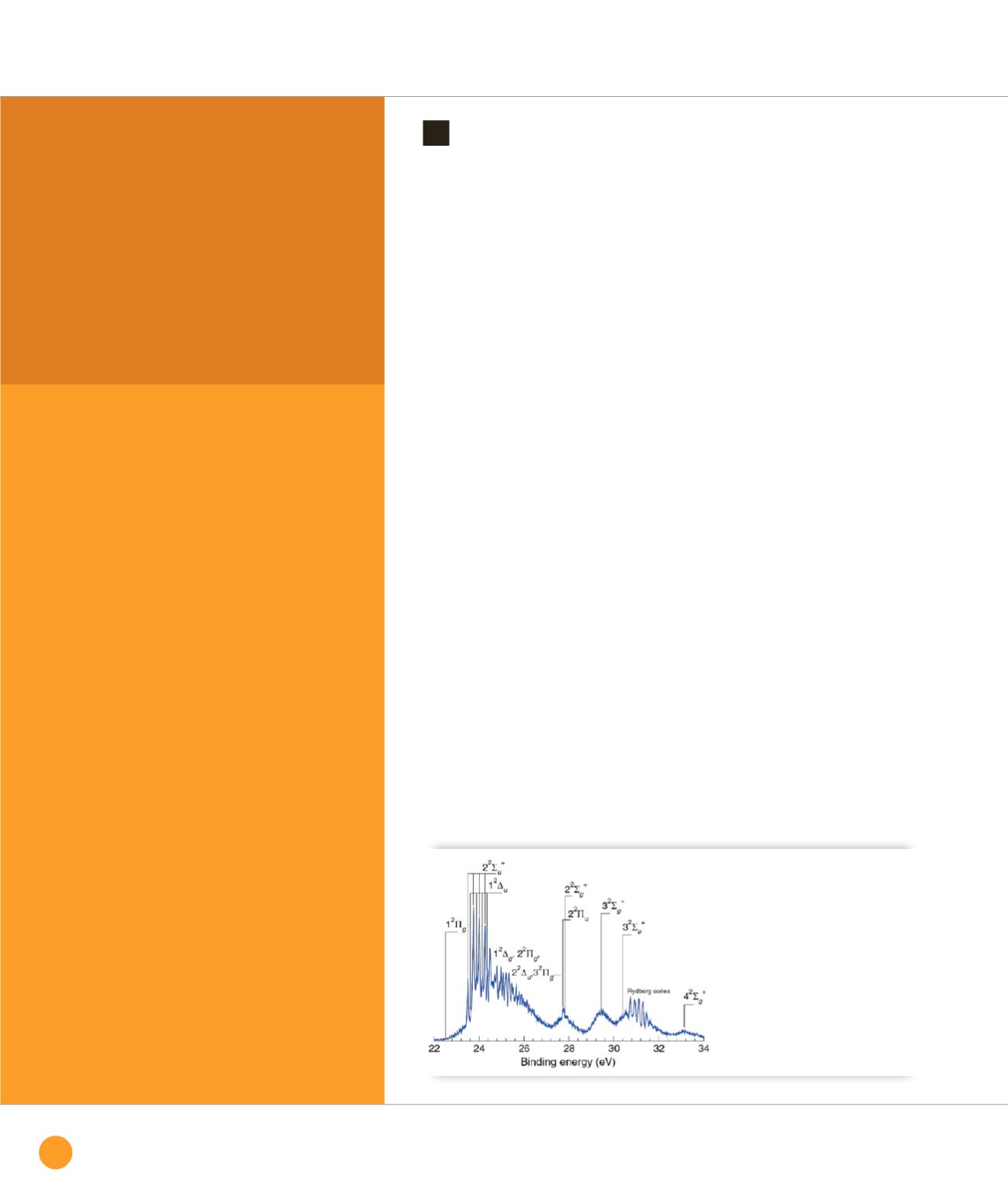
Advanced studies
of molecular ions by
resonant photoemission
The possibility to explore excited states
of molecular ions is of high interest for
the investigation of the chemistry of still
mysterious/unknown planetary atmospheres.
The work done at the PLEIADES beamline [1]
provides new information on the electronic
structure of the nitrogen ions with a
precision never achieved before. Synchrotron
radiation with high brightness and a narrow
bandwidth has allowed us to perform
measurements in a sublifetime regime,
exciting a selected vibrational substate
of the intermediate N 1s-π * core-excited
stateand therefore controlling the spatial
extension of the vibrational wave function.
We combined the ultrahigh-resolution
resonant photoemission (RPE) [2]
measurements with accurate
ab initio
configuration-interaction calculations of
the molecular potentials and of the nuclear
wave-packet dynamics. The powerful
synergy of sophisticated experimental and
theoretical methods has allowed us to make
a detailed analysis of molecular states, thus
emphasizing the full potential of the resonant
x-ray spectroscopies.
With the help of advanced theoretical
modeling twelve electronic states forming
the so-called “spectator” bands have been
assigned and accurately characterized
in N
2
+
(Fig.
➊
). These characterizations
were not achievable in previous
measurements and have only become
possible in our experiment by tuning
the excitation energies up to those
of the highest-vibrational-quantum-
number, low-cross-section vibrational
substrates [3]. The use of the highly
excited vibrational sublevels (v=5,6)
was essential for the accurate potential
reconstruction since - owing to the wide
distribution of their wave functions - only
these states allow one populating the
lowest vibrational substrates in some final
electronic states that were targeted in our
study (Fig.
➋
). Using the superposition
of the RPE spectra shown in Fig.
➋
c
,
the vibrational energies of few lowest
vibrational sublevels of the 1
2
Π
g
and
1
2
Δ
g
states were clearly identified, which
allowed obtaining the most important
spectroscopic constants of these potential
energy curves (PECs). The 1
2
Δ
g
state has
never been observed before since its
vibrational progression becomes visible
only after high vibrational excitation
of the intermediate state in the RPE
process, and this has not been explored
prior to the present measurements.
The resonant scattering cross section
is known to be proportional to the square
of the wave function of the vibrational
sublevel involved in the scattering process.
Ultrahigh spectral resolution, together with
high-level theoretical simulations, has
allowed us to clearly demonstrate
the phenomenon of the mapping of core-
excited wave functions. Going beyond
the initial prediction made for dissociative
final states [5], we have shown that this
mapping phenomenon is also observable
for bound final states far from the
equilibrium geometry (Fig.
➌
a
). The final-
state PEC shows a dissociative-like
character at short bond lengths resulting
in a broad feature in the RPE [(1) in
Fig.
➌
a
], while the right classical turning
point of the core-excited wave packet
corresponds to a binding energy below
the dissociation limit of the final state,
resulting in a vibrational progression
observable on top of the dissociative-
like resonance (2) in Fig.
➌
a
. The total
envelope of the RPE profile maps the
square of the vibrational wave function
Ψ
1
of the core-excited state with reasonably
high accuracy, which was observed
experimentally for the first time. Our time-
dependent numerical simulations showed
that the ultrafast final-state wave-packet
dynamics can be steered by controlling
the excitation energy, allowing the selection
of the vibrational wave functions in the
core-excited state to be made (Fig.
➌
b
).
Using the textbook example provided
by the nitrogen molecule, we have shown
the richness of the RPE framework that
combines state-of-the-art experimental
and theoretical methods. The approach
is general and can be extended to
advanced studies of the excited ionic
states of larger molecular species and
easily transposed to neutral molecular
states by detecting the radiative decay.
ATOMIC AND MOLECULAR PHYSICS, DILUTE MATTER, UNIVERSE SCIENCE
➊
Experimental RPE spectra
with x-ray photon energy tuned
to the resonance with the ground
vibrational sublevel of the N 1s-π*
core-excited electronic state [3,4].
74
SOLEIL
HIGHLIGHTS
2013


